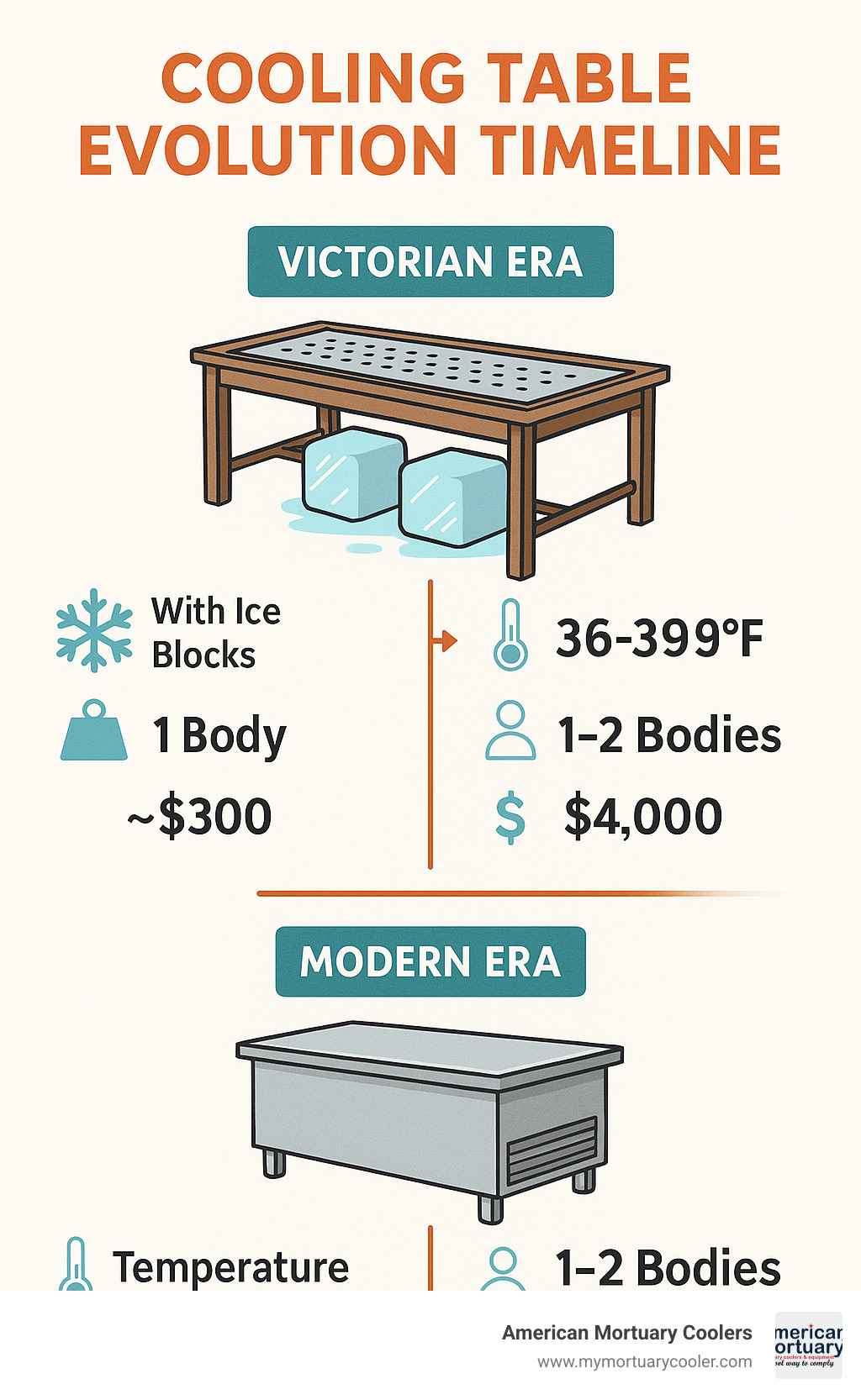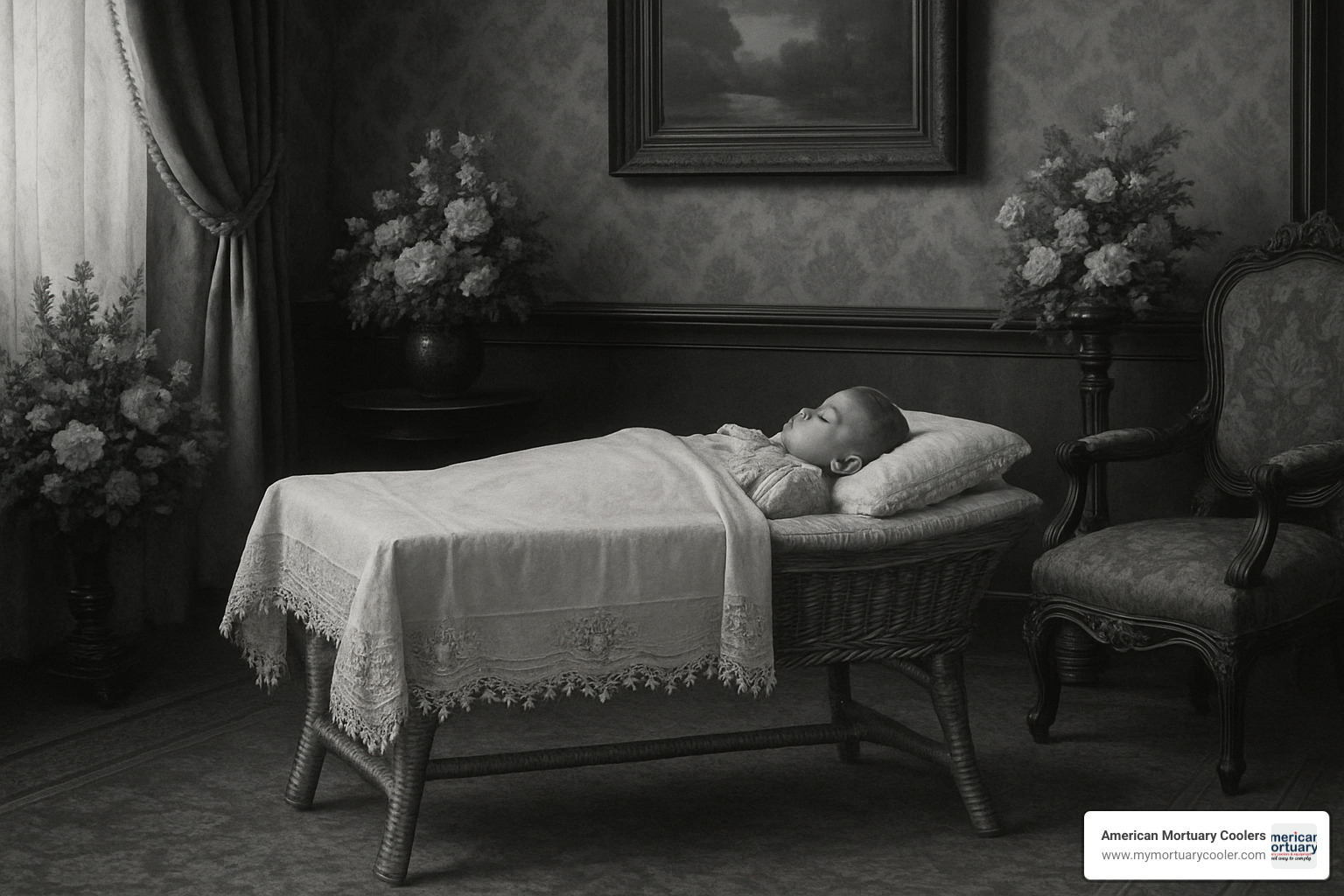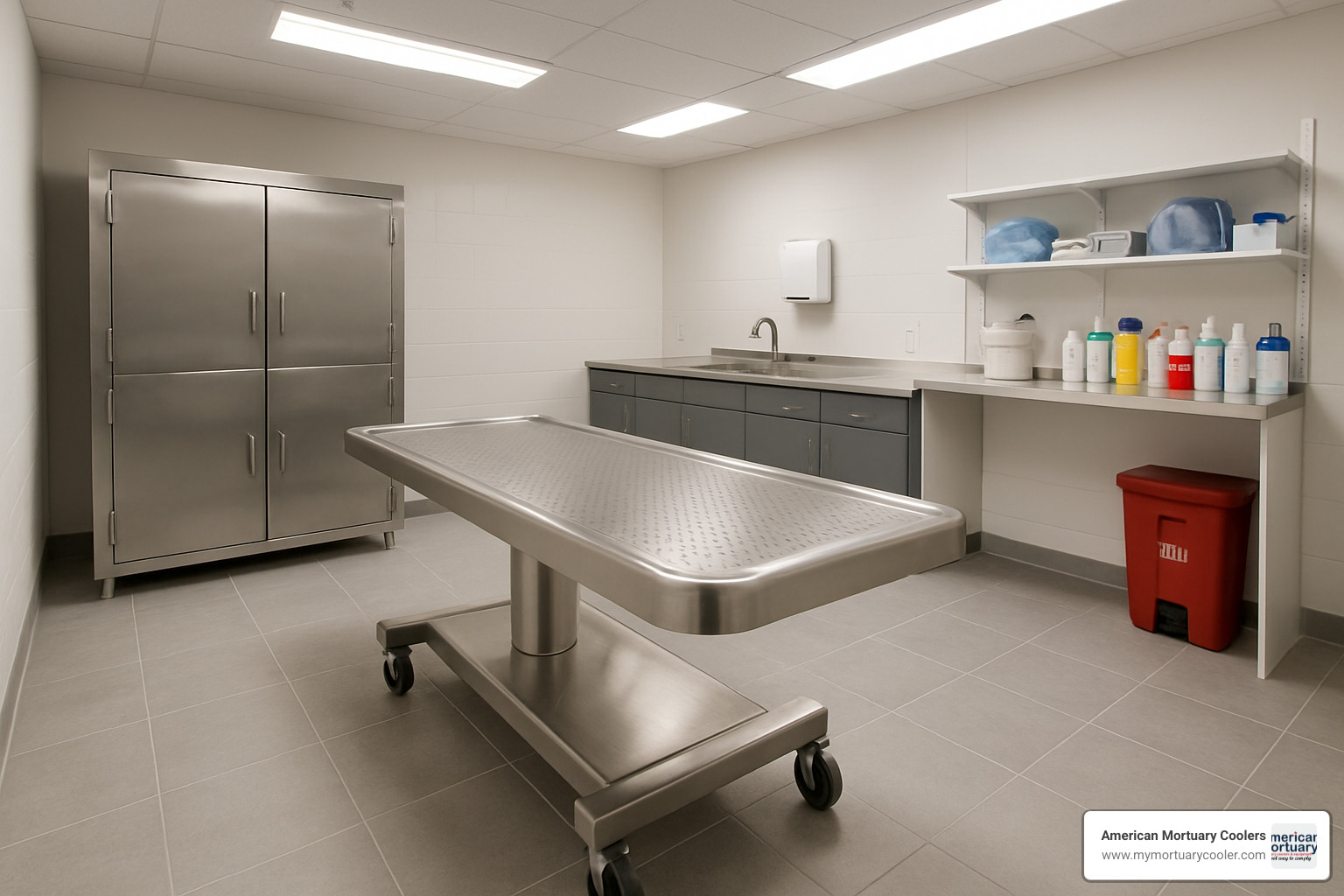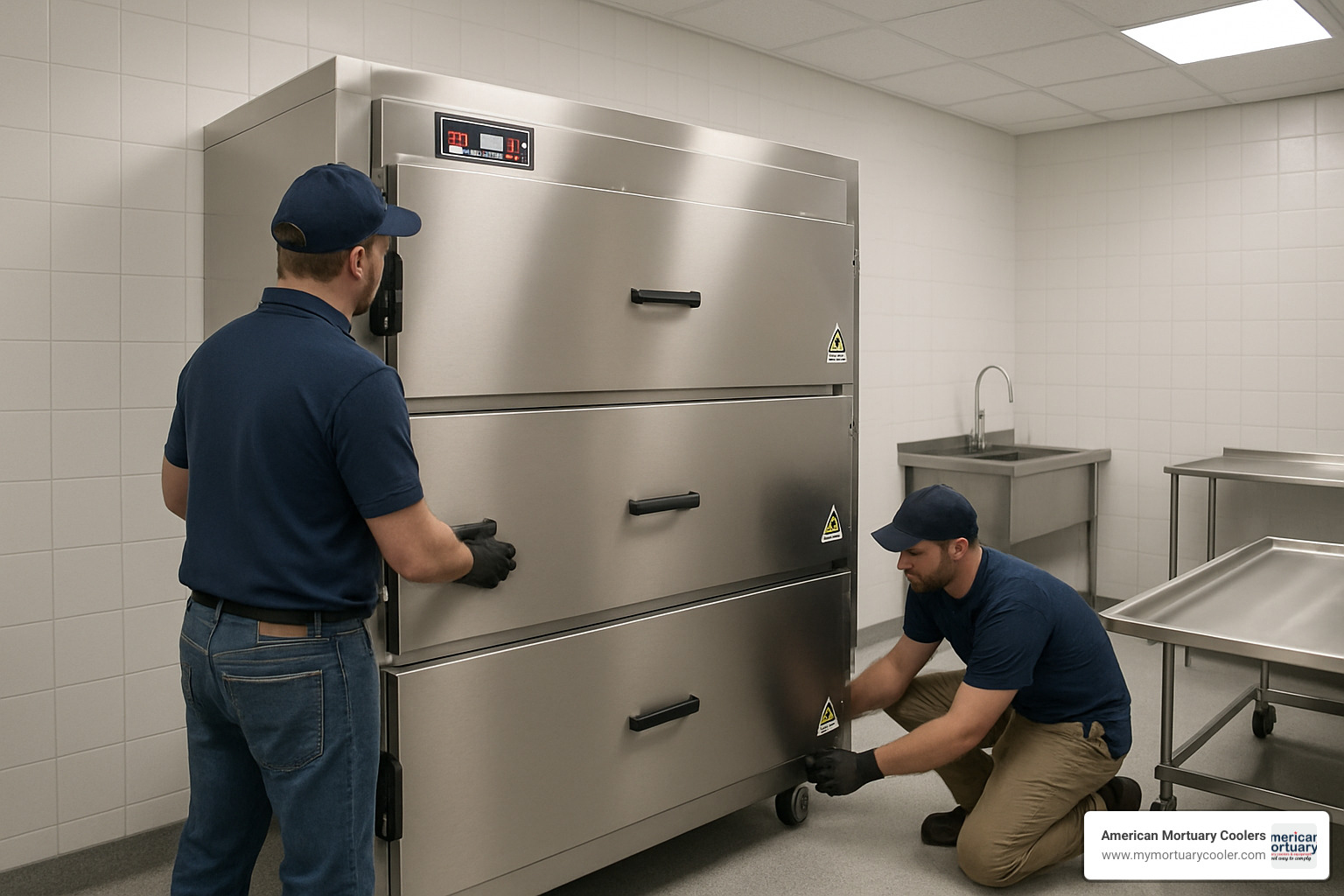Understanding the Critical Role of Body Preservation in Funeral Service
A cooling table in funeral home settings is a specialized platform designed to preserve a deceased body before burial or cremation. These tables serve as essential equipment for maintaining dignity and slowing decomposition during the funeral preparation process.
Quick Guide to Cooling Tables in Funeral Homes:
| Purpose | Types | Temperature Range | Modern Features |
|---|---|---|---|
| Body preservation without embalming | Victorian wooden/Stainless steel modern | 36°F-39°F (optimal) | Digital thermometers, telescoping slide rails, LED lighting |
| Viewing platform during wakes | Fixed/Mobile/Walk-in coolers | N/A (for non-refrigerated) | Height adjustability, forklift compatibility |
| Embalming surface with drainage | 2-6 body capacity units | N/A (for dry ice methods) | Blower plenums, vapor capture |
The history of cooling tables in funeral homes stretches back to the Victorian era when most funerals were conducted at home. Before modern refrigeration, these tables featured perforated surfaces placed over blocks of ice, allowing for natural cooling and fluid drainage.
Today's funeral professionals have access to sophisticated cooling options ranging from traditional tables to complete walk-in refrigeration units. The choice depends on facility size, budget constraints, and specific needs of the communities served.
While embalming became common practice in the 20th century, many families now request more natural approaches, making efficient cooling systems increasingly important for modern funeral homes.

Quick cooling table in funeral home definitions:
What Is a Cooling Table in Funeral Home Practice?
A cooling table in funeral home practice is a specialized platform that helps preserve the body of a loved one after death. Think of it as a dignified resting place that slows natural processes without chemical embalming, giving families precious time to gather and say goodbye.
These tables work by keeping the body at a cool temperature—typically between 36°F and 39°F. This sweet spot is important: cold enough to significantly slow decomposition, but not so cold that tissues freeze and become damaged. It's a gentle approach that honors the natural process while maintaining the dignity of the deceased.
Traditional cooling tables have a practical design with perforated surfaces. These small holes serve double duty—they allow cold air to circulate around the body and provide a pathway for natural fluids to drain away. In older designs, these fluids would collect in special containers placed beneath the table.
Before modern refrigeration, cooling tables in funeral homes relied on blocks of ice placed under the perforated surface. Today's versions use refrigeration technology, but the principle remains the same—maintaining the perfect temperature for preservation without chemicals.
How a cooling table in funeral home preservation works
The science behind a cooling table in funeral home settings is straightforward. It's about managing temperature to slow the biological processes that naturally occur after death.
During life, our bodies maintain a warm 98.6°F. After death, the body gradually cools to room temperature—a process called algor mortis. A cooling table speeds up and extends this cooling through three main principles:
- Conduction - The cold surface directly cools the body through contact
- Convection - Circulating cold air carries heat away from the body
- Radiation - The body naturally releases heat to the cooler environment
Modern refrigerated cooling tables in funeral homes maintain that crucial 36°F-39°F range—cold enough to slow bacterial growth without freezing tissues, which would damage cells and complicate preparation.
According to scientific research on refrigeration principles, lowering body temperature by just 10 degrees can cut decomposition rates in half—making cooling one of the most effective natural preservation methods available.
Key roles during home viewings and wakes
Before funeral homes became common, the cooling table in funeral home practices (or more accurately, in-home practices) served multiple important purposes that shaped how we honor our dead.
Most practically, these tables bought precious time. When news traveled slowly and relatives might take days to arrive by horse or train, cooling tables slowed decomposition long enough for everyone to gather and say goodbye.
These tables also served as dignified viewing platforms. Families would cover them with their finest linens or special quilts, creating a respectful presentation while hiding the functional aspects underneath.
In rural America, particularly Appalachian regions, cooling tables became part of unique cultural traditions. When winter deaths occurred and the ground was too frozen for burial, bodies would be placed on cooling boards and stored in barns until spring. As one historical account notes, families would simply "Put the corpse in the barn till spring"—a practice born of necessity that became woven into regional funeral customs.
Today, with renewed interest in home funerals, modern versions of cooling tables are helping families reclaim these traditions of personal care for their loved ones.
The Evolution of the Cooling Table: From Victorian Parlors to Modern Prep Rooms
The journey of the cooling table in funeral home practice tells a fascinating story that mirrors how our society's relationship with death has evolved. In the 1800s, when nearly 90% of Americans said their final goodbyes in the family home, cooling tables weren't just funeral equipment—they were essential household items that appeared during times of loss.
The Victorian era brought remarkable innovations to these tables. B.F. Gleason emerged as the premier manufacturer, securing patents in 1881 and 1886 for designs that transformed the industry. These tables featured clever folding mechanisms with handles, allowing traveling morticians to easily transport them for in-home preparations.
Perhaps the most heart-touching aspect of historical cooling tables was the creation of child-sized models. In an age when childhood mortality rates were devastatingly high, these smaller tables reflected a sad reality many families faced.

Victorian-era cooling tables often featured wicker caning—a design choice that was both practical and beautiful. The woven pattern allowed better airflow and drainage while giving the table a more refined appearance than simple drilled wood.
As the 20th century unfolded, funeral practices gradually moved from parlors to professional establishments, and cooling tables evolved alongside this shift. The introduction of electric refrigeration in the 1930s and 40s revolutionized preservation methods. After World War II, mechanical refrigeration became the standard in funeral homes, marking the birth of modern mortuary coolers.
Cooling table in funeral home history before modern embalming
Before modern embalming became widespread in the late 19th century, the cooling table in funeral home history played a crucial role in preserving the deceased. These early tables relied entirely on ice, creating a fascinating connection between seasonal industries and funeral practices.
Ice harvesting was big business in 19th-century winters. Workers cut blocks from frozen lakes and rivers, storing them in insulated ice houses for year-round use. This harvested ice became essential for cooling tables, creating seasonal challenges for funeral practices.
The design of pre-embalming cooling tables was brilliantly practical. Cane lattice boards or perforated wooden platforms allowed melting ice water to drain away from the body while maintaining the cooling effect. Many featured folding legs for easy storage and transport.
Traveling morticians would carry these portable cooling tables from house to house, particularly in rural communities where funeral parlors didn't exist. They would arrive with their folding table, preparation tools, and precious blocks of ice to care for the deceased in the family's home.
Modern refrigeration tables and mortuary racks
Today's cooling table in funeral home settings has undergone a remarkable change from its historical ancestors. Modern refrigeration tables typically feature high-grade stainless steel construction, offering superior durability, sanitation, and ease of cleaning.
One of the most significant innovations in modern cooling tables is the addition of blower plenums—specialized ventilation systems that capture potentially harmful vapors right at their source. This feature creates a safer workplace for funeral professionals while maintaining better air quality throughout preparation areas.
Height-adjustable models have become increasingly popular, allowing funeral directors and embalmers to work at comfortable levels that reduce physical strain during lengthy preparation procedures. Many modern tables feature smooth hydraulic or electric lift mechanisms capable of supporting up to 1,000 pounds.
For funeral homes with limited space or fluctuating needs, multi-tier mortuary racks provide smart vertical storage solutions. These systems come in various configurations—from 2-tier to 5-tier models—with different loading options to match a facility's specific layout.
Modern units maintain precise temperatures between 36°F and 39°F regardless of the weather outside, often including digital temperature controllers, LED interior lighting for better visibility, and alarm systems that alert staff to any temperature fluctuations.
Operational Considerations: Sizing, Types, and Best Practices
When it comes to choosing a cooling table in funeral home settings, there's quite a bit to think about. Like buying a car or a home, this is an investment that needs to match your specific needs and circumstances.
Let's start with sizing options. Just as we recognize that people come in different sizes in life, funeral homes need equipment that respects these differences in death. Adult-sized tables are standard, but many facilities also maintain pediatric cooling tables for the care of younger decedents. Today's adjustable models often serve both purposes, which helps smaller funeral homes manage their space and budget more effectively.
Fixed or mobile? That's another key decision. Fixed tables offer rock-solid stability and can support more substantial refrigeration systems. Meanwhile, mobile units give you the flexibility to reconfigure your preparation areas or move between preparation and viewing spaces as needed.

For busier establishments, walk-in cooler systems offer an efficient solution for storing multiple bodies. Think of them as specialized rooms dedicated to preservation rather than individual tables. They're particularly valuable during unexpected community emergencies or seasonal surges when capacity becomes critical.
Always have a backup plan! Power outages happen, equipment occasionally fails, and families still deserve proper care during these disruptions. Dry-ice protocols provide reliable emergency cooling, so it's wise to maintain supplies or establish vendor relationships before you need them.
Budget-conscious funeral directors might consider the innovative CoolBot DIY room system. This clever technology converts standard rooms into functional walk-in coolers using regular air conditioners paired with specialized controllers. At around $5,000 for implementation (compared to $15,000+ for commercial systems), it offers substantial savings while maintaining proper preservation temperatures.
Choosing the right cooling table in funeral home settings
Finding the perfect cooling table in funeral home operations isn't one-size-fits-all. Your case volume should guide your decision-making process. If you're handling fewer than 100 cases annually, a single cooling table or small 2-body cooler might be perfectly sufficient. Larger operations might need multi-tier systems or walk-in units to manage their workflow efficiently.
Your local climate matters tremendously. Facilities in warmer regions face greater preservation challenges than those in cooler climates. If you're in an area where temperatures regularly climb above 90°F, look for high-ambient temperature models with improved compressor systems.
Budget realities can't be ignored, but think long-term. Premium stainless steel units with advanced features typically run $6,000-$15,000, which represents a significant investment. However, their durability and energy efficiency often make them more economical over their operational lifespan.
Your staff's wellbeing matters too. Height-adjustable tables and hydraulic lifts significantly reduce injury risk during transfers and preparation. These ergonomic features might add to initial costs, but they prevent costly worker compensation claims and lost productivity.
Energy efficiency pays dividends both environmentally and financially. Modern cooling tables with high-efficiency compressors and superior insulation can significantly reduce your monthly utility bills compared to older models.
Legal, Health, and Maintenance Guidelines
Running a cooling table in funeral home operations isn't just about having the right equipment—it's about navigating a complex web of regulations that protect public health and ensure dignity for the deceased. These guidelines vary significantly depending on where you're located.
State regulations can differ dramatically across regions. Some states strictly require refrigeration for any body not embalmed within 24 hours, while others offer more flexibility in their approach. As a funeral director, you'll need to become intimately familiar with your local requirements, which are typically outlined in your state funeral board regulations or public health codes.
One nearly universal requirement is the mandatory waiting period between death and cremation—usually 24-48 hours. This waiting period exists primarily to allow for proper death investigations when circumstances warrant them. This regulation alone makes adequate cooling capacity essential for virtually every funeral home, regardless of their embalming practices.
When it comes to temperature standards, there's more consistency nationwide. The optimal range for body preservation without freezing is 36-39°F (2-4°C). Maintaining this narrow temperature band requires reliable equipment with precise controls and monitoring systems.
Biohazard management around cooling tables deserves special attention. Proper fluid handling and sanitization aren't just good practice—they're typically mandated by law. Drainage systems must comply with local wastewater regulations, often requiring specialized treatment before fluids can enter municipal systems.

Staff safety requires appropriate personal protective equipment when working with cooling tables. This includes fluid-resistant gowns or aprons, nitrile gloves (doubled for known infectious cases), face shields during procedures that might generate splashes, and respiratory protection when indicated by specific circumstances.
Collectibility and museum value of antique tables
There's something hauntingly beautiful about antique cooling tables in funeral home history. These artifacts have transcended their utilitarian origins to become sought-after collectibles and museum pieces that connect us tangibly to historical mourning practices.
The market for these historical pieces has grown steadily, with well-preserved Victorian cooling tables typically fetching between $1,000 for basic models to over $6,000 for exceptional examples. Provenance matters enormously in this specialized market. A cooling table with documented use in notable historical contexts commands premium prices.
When you visit museums featuring death customs exhibits, cooling tables frequently serve as anchoring pieces that help contextualize broader narratives about Victorian mourning rituals or the evolution of American funeral practices. The Smithsonian and various regional history museums have incorporated these tables into their collections, recognizing their significance in American cultural history.
Market options & manufacturers to know
Today's cooling table in funeral home market offers diverse options from specialized manufacturers, each with distinct advantages depending on your facility's needs, budget, and aesthetic preferences.
Looking back, B.F. Gleason dominated the cooling table market in the late 19th century. Many surviving antique tables bear Gleason's patent dates—April 12, 1881, and September 7, 1886—stamped directly into their hardware.
For contemporary options, EIHF Isofroid stands as an industry leader, particularly for premium European-designed cooling tables. Their reputation rests on several distinguishing features, including CE certification and compliance with international standards, comprehensive 48-hour pre-shipment testing of each unit, and guaranteed 10+ year spare parts availability.
If you prefer American-made equipment, Mobi Medical offers competitive pricing on domestically manufactured cooling equipment. Their product line includes configurations accommodating 2-6 bodies, with American-made construction backed by impressive 15-year panel and door warranties.
For budget-conscious operations or those needing rapid deployment, the innovative CoolBot walk-in cooling system provides an intriguing alternative. This clever system allows conversion of standard rooms into walk-in coolers using regular window air conditioners paired with specialized controllers.
Frequently Asked Questions about Cooling Tables
Do I need embalming if I use a cooling table?
One of the most common questions we hear from families is whether embalming is necessary when using a cooling table in funeral home settings. The simple answer is no - embalming is not legally required in most situations when proper refrigeration is used.
The Federal Trade Commission has actually created regulations that specifically prohibit funeral homes from claiming embalming is legally required except in very limited circumstances. This gives families more options when making arrangements for their loved ones.
Refrigeration on a cooling table provides an effective alternative to chemical preservation methods. This approach works particularly well for families with religious or philosophical objections to embalming, those planning green burials where chemical-free preparation is preferred, or when there will be just a brief delay (typically 3-5 days) between death and final disposition.
That said, there are situations where embalming might still be recommended or required - such as when there will be extended delays before services, when shipping remains across state lines, or in certain cases involving infectious conditions.
How long will a body stay preserved on a cooling table in funeral home conditions?
When properly refrigerated between 36°F and 39°F, a body can remain appropriately preserved on a cooling table in funeral home settings for approximately 3-4 weeks. However, several factors influence how long effective preservation will last.
The timeline for preservation begins the moment life ends. Ideally, cooling should begin within 4-6 hours after death for optimal results. The deceased's physical condition and any pre-existing medical factors also play important roles in how well preservation methods work.
Consistent temperature maintenance without fluctuations is absolutely critical. Even brief periods of higher temperatures can accelerate decomposition processes. The ambient humidity and environmental conditions in your preparation room also affect preservation quality, which is why climate control is so important in these spaces.
For families choosing home funerals with non-refrigerated cooling methods such as dry ice or polymer refrigerants, preservation typically remains effective for 3-5 days with proper application and regular replacement of cooling materials.
What size cooling table should a small funeral home purchase?
For small funeral homes handling fewer than 150 cases annually, a 2-body cooling table in funeral home configuration typically provides the sweet spot for most operations. This gives you enough capacity for routine operations while still accommodating those occasional overlapping cases that inevitably happen.
When helping funeral directors determine the right size for their facility, we consider several important factors. First, we look at your average case volume and identify any seasonal peaks you might experience. We also discuss your typical service timing - homes that offer longer viewing periods naturally need more capacity to accommodate everyone.
Community demographics play a significant role too. If you serve an aging population, you might need to plan for increased capacity in the coming years. And of course, we need to work within your facility's space constraints and budget limitations, balancing immediate needs with room for future growth.
Conclusion & Next Steps
As we've journeyed through the history and evolution of the cooling table in funeral home settings, we've seen how these essential tools have transformed while maintaining their core purpose—preserving the deceased with dignity and care.
From the Victorian-era wooden platforms cooled by blocks of ice to today's precision-engineered refrigeration systems, cooling tables reflect our profession's ability to honor tradition while embracing innovation. They stand as silent witnesses to changing funeral practices across generations.
Today's funeral director faces choices that would amaze their predecessors. The modern cooling table in funeral home operations might be a traditional single platform, a space-efficient multi-tier system, or even a complete walk-in unit—each offering reliable preservation while respecting both regulatory requirements and families' wishes for natural preparation approaches.
What have we learned on this journey? Cooling tables do far more than preserve—they serve as dignified viewing platforms and preparation surfaces. The simple ice methods of yesterday have evolved into precisely controlled environments. Modern designs balance traditional dignity with thoughtful features like height-adjustable surfaces and vapor management systems.
If you're evaluating your funeral home's cooling needs, start with an honest assessment of your current and future case volume. Consider your building's unique layout, your budget realities, and how your community's needs might evolve in coming years. The right solution balances today's requirements with tomorrow's possibilities.
Here at American Mortuary Coolers, we believe every funeral home deserves cooling equipment that fits their unique circumstances. From our Tennessee headquarters and regional service centers, our team provides personalized consultation, custom design work, nationwide delivery, and professional installation services throughout the continental United States.

For more guidance on finding the perfect cooling solution for your establishment, we invite you to explore our complete guide to choosing a funeral home cooler or reach out to our consultants for recommendations custom to your specific needs.


















